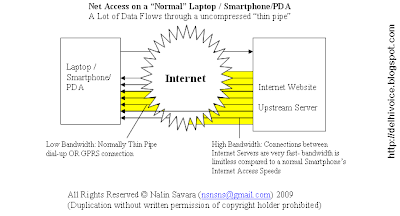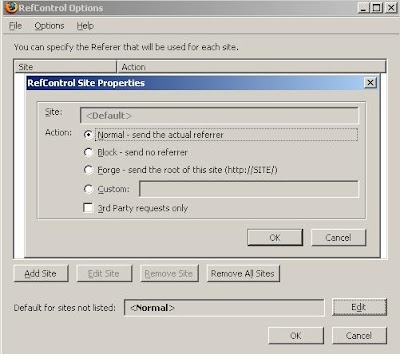
It’s longer than a Nokia E61/E95/E71.
But it’s thinner than a Nokia E90 communicator.
But appearances apart; it’s faster at Net-access than your Dell - but with less multimedia than even the multi-ringtone basic phone used by our cleaner-woman; what is this ?.
It’s the DataWind PocketSurfer!!!
This is a device which has the potential to emerge as being in a class by itself.
It is'nt labelled as one-- but it works just like a PDA or Smartphone- which uses a SIM-card from a local mobile services provider (Airtel) to access the internet using a data-plan.
This is a device which has the potential to emerge as being in a class by itself.
It is not labelled as one-- but it works just like a PDA or Smartphone- which uses a SIM-card from a local mobile services provider (Airtel) to access the internet using a data-plan.
But that is where the similarity with smartphones ends—because it is minus the voice telephony, video, camera and sound features- and it brands itself as being in the category of “mobile internet access devices”.
When I first surfed to DataWind’s website after seeing the invitation to DataWind’s press conference- I was skeptical- and wondered- is this a scam ? or is this a average-to-mediocre product branded as the next big thing? Fortunately for me, it was a good product that came as a breath of fresh air.
Here’s why, the good, the bad and the ugly of the DataWind PocketSurfer: my overall impression, followed by photos and technical details- and finally the limitations- which I see as the stumbling blocks- that will make or break this product’s success in the market.
This product is perhaps one of the few come-up-from-behind products that really has the potential to kick the biggies out of their comfortable perches. If it evolves, it can give the iPhones and Nokia E90s of the world a run for their money (and I say this not as someone with any attachment to the PocketSurfer but as a user who has shelled out hard earned money first for a Nokia E61 and then for a Nokia E90).
This product needs to evolve a lot- to become as perfect or as mature as a iPhone.
But no matter what- one has to admit that DataWind, with it’s PocketSurfer product has the potential to shift and totally re-shape the SmartPhone and internet-access device landscape.
So, here goes- what follows is a lowdown on DataWind’s PocketSurfer product… as I saw it- and as it was related to me by DataWind’s very helpful team.
The Product:

What else sets the PocketSurfer apart ?
Form Factor:
The PocketSurfer is a 6 x 3.98 x 0.6-inch device, that’s got a flip-open form factor and a qwerty keyboard reminiscent of the Nokia E90 and the Nokia 9xxx series communicators- but it’s longer than a E61 and at the same time thinner and lighter than a Nokia E90.
GPS: That’s a awesome nice to have- atleast on paper- but we never did get a chance to see it NOR a chance to actually play with the PocketSurfer’s advertised GPS capability- so no comments on this.
Keyboard:
The Keys atleast 5-times bigger than the keys of a Nokia E90 Communicator or the Keys of a Nokia E61 or E71.
These are keys which are backlit, and can be pressed as you stand in a airport- checking for cheaply priced tickets.
The screen is BIG- 640x240 – that’s not as big as a laptop’s screen- but it’s definitely big enough to show most web-pages the way the designer intended you to see them.
And for those of us who want to check stock quotes and book tickets on pages designed for PCs-- these DataWind folks really have worked hard- on getting the ergonomics of showing webpages right- with a “scroll lock” key (lets you use the 4-way arrow keys to move around a webpage- without affecting the position of the nouse pointer.
There are also keys to temporarily zoom into or shrink parts of a webpage.
Selection and Mouse Pointer Motion:
There’s a key for mouse clicking and there’s a touch pad like those on laptops—for moving the mouse pointer around and just like a laptop, tapping the touch-pad has the effect of double-clicking the mouse pointer.
Download Speeds:
It can display webpages blazingly fast- like for example you can browse to- and open a 50 megabyte PDF file from a website- in under 5-seconds.
When I tried out the PocketSurfer- I saw that’s true; but when I heard it, that sounded crazy- even to me- the more I’d listen, the more exaggerated this claim would sound- so I spent the time, listening to these folks and figuring how exactly such blazingly fast speeds are possible.
So, for those of us that like to know it all—here’s how the PocketSurfer manages it’s speeds:
How ? Because it’s web-browser accesses the files through a intermediate server- which uses high speed server-to-server internet connections to “get” the file to the server- and then the server sends out pre-rendered versions of the heavy webpage to the user’s webbrowser running on the PocketSurfer.
It also has a host of advanced and patented file-compression technologies- through which DataWind’s servers and web-browsers get compressed versions of the files shrunk to far beyond what’s possible with standardized web-protocols.
Weight:
It’s much lighter than a Nokia E90 and it has keys that are atleast 5-times bigger than the Nokia-E90’s keys- which makes the keys easier to press- all the better for one-handed typing, while walking or standing.
External Connectivity:
As per script, Here’s DataWind’s take on PocketSurfer’s External Connectivity, the quotes and the emphasis is all mine (Delhi Voice Blogs’):
“Since the PocketSurfer is a Internet Access Device- and since each pocketSurfer device has 50 MB of space on DataWind’s Midstream server(see diagram), therefore, to stick to it’s planned positioning and to keep costs low, the PocketSurfer has only internet connectivity through a packet data enabled SIM card, and there is no Bluetooth, WiFi or USB connectivity between the PocketSurfer and any external PC or Laptop or Smartphone- all file transfers etc can be done through the internet- but uploading the file to the internet and downloading the file onto the PocketSurfer.”
Pricing:
The PocketSurfer costs Rs 11,995 suggested retail price- and the street price is expected to be lower… lets see, how low!
Limitations:
In this blogger’s view, external connectivity is the weakest part of PocketSurfer’s value proposition. That means:
Dependance on mobile network coverage: in a situation of limited or zero mobile network coverage, the PocketSurfer is limited to the point of being unusable- whereas, a normal smartphone or laptop could still do a lot—even without internet connectivity or mobile network coverage.
Data Access Charges: The PocketSurfer’s midstream servers can greatly use data usage- I feel that the offered “Free 35 hours a month for the first 12 months” would still prove to be a stumbling block.
Here’s why ? It’s just a unqualified opinion- but imagine this: read your mails and compose 4-5 mails—and poof!!! You’ve used maybe a hour of net access time; do that daily, and before the month is finished, you’ve completed your 35 hour quota.
Once the net access quota for the month is finished- what else is there to do ? nothing- nothing at all- no mp3 playing and no movie clip watching, not even a way to locally edit and draft documents without being connected to the internet.
- Getting Data Off the PocketSurfer: No Bluetooth, no wifi connectivity, and no USB cable to transfer files from the PocketSurfer to a PC/Laptop or other smartphone.
Will this affect most users ? Depends on the user- but to power-users like me, this is bad!!!
Beyond this first impression: Complaints ? Complaints ? Praise ?
Nopes… that’s it…
this is where the press conference ends.
Someday soon, the DelhiVoice will indeed get a chance to play with the PocketSurfer… maybe after buying one from the local market or borrowing one from a friend… and then; that’s when I guess the real story… praise and pitfalls will come out.
Till then… watch this space!!!
Monday, February 23, 2009
DataWind PocketSurfer Previewed– A first impression shared
Thursday, February 12, 2009
RefControl - Stop those thieves ;)
RefControl is the latest firefox addon. This control prevents the websites from peeping into our recent web history.
When we go to a website, the scripts in the page could easily find out the site from which we had visited the site or in short the referring website. This is an inbuilt functionality in the internet mechanism which lets the webmasters determine the source and then improve their commerce and business models.
But many consider this to be an infringement of their privacy and have been complaining. The RefControl addon may solve this predicament. It will block all the websites from reading the recent history. It can also be configured to send null value or a custom message.
It can be downloaded from here. Once installed, it will be reflected in under the tools menu. The interface looks like this and is very easy to work around.
By default, RefControl blocks all the sites from reading the data. It is very easy to use and can be
configured very easily.
One has to add the website and then select one of the three given options, whether to block, or send the null value or send a default message.
Thursday, February 5, 2009
Offline Gmail
Reading your emails offline from the browsers itself seems to be a better option tha using the email clients mainly due to the fact that one gets to use the same email interface when done from the browser as against the complex interfaces some of the email clients offer.
Google is extending this offline feature in its Gmail with the help of Google gears. Gears is an open source browser extension that lets developers create web applications that can run offline. Gears is currently a beta product; moreover, it is currently considered to be a developer-only release. Gears extends browsers by making new APIs available to JavaScript code.
Gmail uses Gears to download a local cache of your mail. As long as you're connected to the network, that cache is synchronized with Gmail's servers. When you lose your connection, Gmail automatically switches to offline mode, and uses the data stored on your computer's hard drive instead of the information sent across the network. You can read messages, star and label them, and do all of the things you're used to doing while reading your webmail online. Any messages you send while offline will be placed in your outbox and automatically sent the next time Gmail detects a connection.
To use this feature, one has to install google gears first. It can be obtained from http://gears.google.com The setup file is a 500Kb file, which gets downloaded in a flash. The installer connects to the internet and downloads the gears application from the google servers after which one has to restart the browsers.
After logging into Gmail, navigate to the settings tab and select the labs option.
Select enable under the Offline section and click save changes button. This section displays all the applications from the google labs' vault which the user has enabled.
After your browser reloads, you'll see a new "Offline0.1" link in the upper righthand corner of your account, next to your username
.
When the link is clicked, gears starts synchronizing the mails and starts to store them in the local hard drive. The status message shows how many have been synchronized and the date till which mails have been backed up.
Once done, one can use it the same way the online version functions.
Everything said and done, this is still an experimental feature and users may send the glitches they come across, to google.







